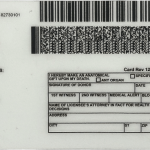In the year 2025, large – scale gatherings have become an integral part of social and business life. From music festivals that draw thousands of attendees to corporate conferences with a wide range of participants, ensuring the authenticity of IDs is crucial for security, compliance, and the overall smooth running of these events.
### The Rising Concern of Fake IDs
The use of fake IDs has been a long – standing issue, but in 2025, with the advancement of technology, the sophistication of fake identification documents has also increased. Young people may try to use fake IDs to gain access to age – restricted events such as concerts with alcohol service or exclusive business – only events. On the other hand, there are also security threats associated with individuals using false identities to enter large – scale gatherings for malicious purposes.
### Technological Solutions
#### Biometric Verification
One of the most prominent methods in 2025 for preventing fake IDs is biometric verification. Fingerprint and facial recognition technologies have become more refined and accessible. Event management companies are increasingly investing in biometric scanners at entry points. For example, at a large – scale music festival, when a ticket – holder arrives, they can place their finger on a scanner or have their face scanned. The system will then compare the biometric data with the information stored in the pre – registered database. This not only helps to confirm the identity of the person but also ensures that the ID presented is genuine as it is linked to unique biological characteristics.
#### Digital ID Verification
Digital ID systems have also gained significant traction. In 2025, many governments and private entities have developed secure digital ID platforms. Event organizers can integrate with these platforms to verify the authenticity of IDs. For instance, when an attendee registers for a corporate conference, they can choose to use their digital ID. The event management system will send a request to the digital ID provider to confirm the details. This process is not only fast but also highly secure as digital IDs are protected by advanced encryption technologies.
### Staff Training and Awareness
Event management staff play a crucial role in fake ID prevention. In 2025, comprehensive training programs are in place to educate them on the latest types of fake IDs and how to detect them. Staff are trained to look for subtle signs of forgery, such as irregularities in the holograms, misaligned text, or differences in paper quality. They are also taught how to handle difficult situations when they suspect a fake ID. For example, instead of immediately accusing an individual, they are trained to politely ask for additional forms of identification or to refer the case to a supervisor for further investigation.
### Collaboration with Law Enforcement
The event management industry in 2025 has strengthened its ties with law enforcement agencies. Prior to large – scale gatherings, event organizers often share information about the expected attendees and any potential security concerns. Law enforcement provides guidance on the latest trends in fake ID production and distribution in the area. During the event, there is a seamless communication channel between the event security team and the local police. If a fake ID is detected, the proper legal procedures can be followed promptly, ensuring that the individual using the fake ID is held accountable.
### Database Cross – Referencing
Event management companies are now using advanced database systems to cross – reference ID information. When an attendee registers for an event, their ID details are entered into the system. This information is then cross – checked with other relevant databases, such as government – issued ID databases or previous event attendee databases. If there are any discrepancies or if the ID has been flagged as potentially fake in other systems, the event management team can take immediate action. For example, if a person has used a different name but the same biometric data in previous events, it can be a red flag for further investigation.
### Common Problems and Solutions
**Problem 1: Technical Glitches in Biometric Scanners**
– **Description**: Biometric scanners may encounter issues such as incorrect readings due to dirty sensors, poor lighting conditions, or the presence of substances on the skin (e.g., hand sanitizer interfering with fingerprint scanning).
– **Solution**: Regular maintenance of biometric scanners is essential. Event management teams should schedule daily checks and clean the sensors. In case of poor lighting, additional lighting fixtures can be installed at the entry points. For issues related to substances on the skin, clear instructions can be provided to attendees, such as asking them to wipe their hands clean before scanning.
**Problem 2: Resistance from Attendees to Biometric Verification**
– **Description**: Some attendees may be reluctant to provide their biometric data due to privacy concerns.
– **Solution**: Event organizers should communicate clearly about the security measures in place to protect the biometric data. They can also offer alternative forms of ID verification for those who are uncomfortable with biometric methods. For example, in addition to biometric scanners, traditional ID card scanners can be available, and the event management team can explain the importance of biometric verification in ensuring the safety and security of all attendees.
**Problem 3: False Positives in Digital ID Verification**
– **Description**: Sometimes, the digital ID verification system may flag a genuine ID as fake due to system errors or data synchronization issues.
– **Solution**: Event management teams should have a backup verification process in place. When a false positive occurs, they can manually review the ID and cross – check with other sources of information. Additionally, they should work closely with the digital ID providers to resolve any system – related issues promptly and ensure that the data synchronization between different systems is accurate.
**Problem 4: Difficulty in Training New Staff Effectively**
– **Description**: With the high turnover rate in the event management industry, training new staff on fake ID detection can be challenging, especially when new types of fake IDs emerge frequently.
– **Solution**: Implementing a comprehensive and updated training curriculum is key. This curriculum should include both theoretical knowledge about fake ID types and practical training on using detection tools. New staff can also be paired with experienced colleagues during their initial days at an event to gain hands – on experience. Regular refresher courses should be provided to keep all staff updated on the latest trends in fake ID prevention.
**Problem 5: Lack of Standardization in ID Verification across Different Events**
– **Description**: Different event management companies may use different ID verification methods and standards, which can lead to confusion for attendees and potential security loopholes.
– **Solution**: Industry associations can play a role in setting up standard ID verification guidelines. These guidelines can cover aspects such as the minimum requirements for ID verification, the types of acceptable identification documents, and the procedures to follow in case of suspected fake IDs. By adhering to these standards, the event management industry as a whole can improve the effectiveness of fake ID prevention at large – scale gatherings.
Fake ID Pricing
unit price: $109
| Order Quantity | Price Per Card |
|---|---|
| 2-3 | $89 |
| 4-9 | $69 |
| 10+ | $66 |


